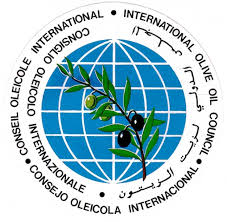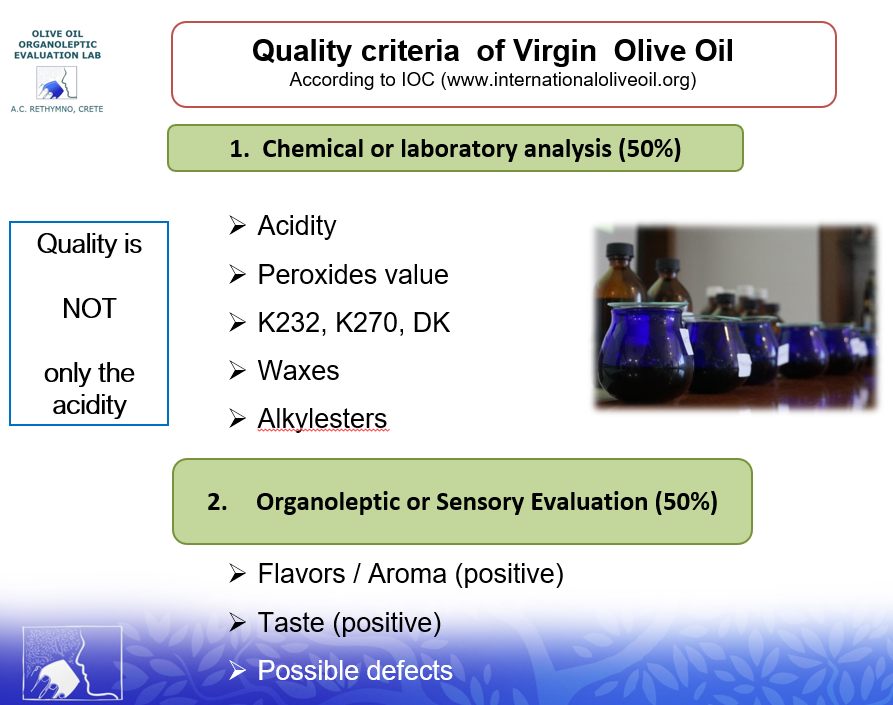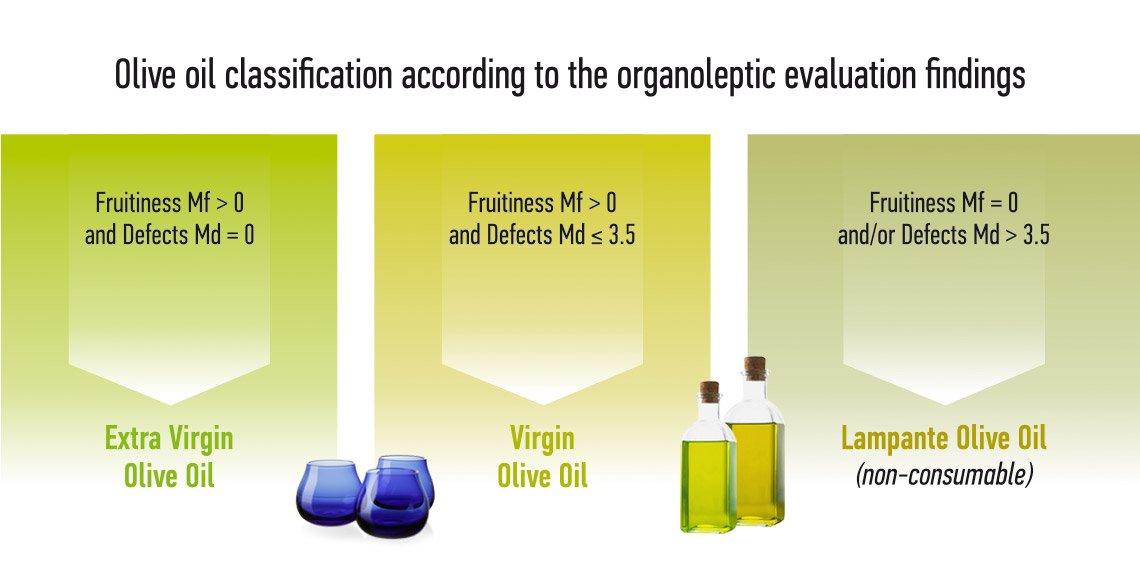What is Organoleptic (sensory) Evaluation in Olive Oil

It is an official method for detect, measure and describe the positive and negative characteristics in virgin olive oil*, by using the human senses.
The evaluation is performed by selected, trained and certified team of tasters (tasting panel), with at least eight members.
The method is world-wide accepted and give us the ability to classify a virgin olive oil in one of the following categories** “Extra Virgin”,”Virgin” or “Lampante”
IT IS AN ESSENTIAL QUALITY CRITERION THAT COMPLEMENTS CHEMICAL ANALYSIS***
*Virgin olive oil is the olive oil produced by mechanical means ONLY
**(according to the existing legislation)
***IOC
What is olive oil?
Virgin olive oils (Extra Virgin and Virgin)** are the oils obtained from the fruit of the olive tree (Olea europaea L. ) solely by mechanical or other physical means under conditions that does not lead to alterations of the olive oil, and which have not undergone any treatment other than washing, decantation, centrifugation and filtration*.
Is the only food product today, with a legislation that describes and evaluates its sensory profile, an obligatory method for dermine it’s quality clasiffication (Extra virgin, Virgin or Lampate) and it’s market value.**
*The olive oil produced in an olive mill, is considered “Virgin” due to the mechanical milling or extraction procedure and will be clasified as Extra Virgin, Virgin or Lampante, only after it’s quality evaluation (Sensory evaluation and Chemical analysis) **
THE INTERNATIONAL OLIVE COUNCIL’S METHOD FOR THE ORGANOLEPTIC ASSESSMENT OF VIRGIN OLIVE OIL

HISTORY
The application of sensory analysis to olive oil began at the Institute of Fats in Seville, Spain, in the 1970s. In 1981, the IOC decided to launch a study to develop a method, based on internationally recognised standards and methods, to objectively assess the taste and colour defined by the oil denominations.
From 1982 to 1986, experts in sensory analysis and olive oil from six countries developed a method, that was adopted by the IOC in 1987 and introduced into legislation in 1991. The standardisation of organoleptic assessment applied to olive oil is now 32 years old. (MADRID / 09.01.2020)*
PURPOSE AND SCOPE
The International Olive Council is the world’s only international intergovernmental organization in the field of olive oil and table olives. It was set up it Madrid, Spain, in 1959, under the auspices of the United Nations. It used to be known as the International Olive Oil Council or IOOC until 2006, when its name was changed.
The Council is a decisive player in contributing to the sustainable and responsible development of olive growing and it serves as a world forum for discussing policymaking issues and tackling present and future challenges.
The IOC is committed to the integrated, sustainable development of world olive growing. It attempts to translate this commitment into tangible advancement for its member countries and, most importantly, for the ordinary people who earn their livelihood from the produce of the olive tree.*
The purpose of the international method is to determine the procedure for assessing the organoleptic characteristics of virgin olive oil and to establish the method for its classification on the basis of those characteristics. It also provides indications for optional labelling.
The method described is applicable only to virgin olive oils and to the classification or labelling of such oils according to the intensity of the defects perceived and of the fruitiness, as determined by a group of tasters selected, trained and monitored as a panel.
More are available on the INTERNATIONAL OLIVE COUNCIL website
COMMISSION DELEGATED REGULATION (EU) 2022/2104 of 29 July 2022 (supplementing Regulation (EU) No 1308/2013 of the European Parliament and of the Council as regards marketing standards for olive oil, and repealing Commission Regulation (EEC) No 2568/91 and Commission Implementing Regulation (EU) No 29/2012
9.4. Classification of the oil
The oil is graded as follows in line with the median of the defects and the median for the fruity attribute.
The median of the defects is defined as the median of the defect perceived with the greatest intensity.
The median of the defects and the median of the fruity attribute are expressed to one decimal place.
The oil is graded by comparing the median value of the defects and the median for the fruity attribute with the reference ranges given below. The error of the method has been taken into account when establishing the limits of these ranges, which are therefore considered to be absolute.
- Extra virgin olive oil: the median of the defects is 0 and the median of the fruity attribute is above 0.
- Virgin olive oil: the median of the defects is above 0 but not more than 3,5 and the median of the fruity attribute is above 0.
- Lampante olive oil: the median of the defects is above 3,5 or the median of the defects is less than or equal to 3,5 and the fruity median is equal to 0.
EU 2022/2104, Article 6. Legal name and labeling of category of oils
1. The description of the oils referred to in Article 1, point (b), shall be considered as their legal name within the meaning of Article 2(2), point (n), of Regulation (EU) No 1169/2011.
2. The label of those oils shall bear, in clear and indelible marking, in addition to the description referred to in paragraph 1, but not necessarily close to it, the following information on the category of oil:
(a) extra virgin olive oil: ‘superior category olive oil obtained directly from olives and solely by mechanical means’;
(b) virgin olive oil: ‘olive oil obtained directly from olives and solely by mechanical means’;
(c) olive oil composed of refined olive oils and virgin olive oils: ‘oil comprising exclusively olive oils that have undergone refining and oils obtained directly from olives’;
(d) olive-pomace oil: (i) ‘oil comprising exclusively oils obtained by treating the product obtained after the extraction of olive oil and oils obtained directly from olives’; or (ii) ‘oil comprising exclusively oils obtained by processing olive pomace and oils obtained directly from olives’.
EU 2022/2104, ANNEX II. Definitions of optional terminology on organoleptic characteristics for labelling purposes
Upon request, the leader of the tasting panel established in accordance with Article 10 of Commission Implementing Regulation (EU) 2022/2105. may certify that the oils which have been assessed comply with the definitions and ranges corresponding solely to the following terms according to the intensity and perception of the attributes.
Positive attributes (fruity, bitter and pungent) according to the intensity of perception:
Robust, when the median of the attribute is more than 6,0.
Medium, when the median of the attribute is more than 3,0 and less or equal to 6,0.
Delicate, when the median of the attribute is less or equal to 3,0.
Fruitiness: set of olfactory sensations characteristic of the oil which depends on the variety of olive and comes from sound, fresh olives in which neither green nor ripe fruitiness predominates. It is perceived directly and/or through the back of the nose.
Green fruitiness: set of olfactory sensations characteristic of the oil which is reminiscent of green fruit, depends on the variety of olive and comes from green, sound, fresh olives. It is perceived directly and/or through the back of the nose.
Ripe fruitiness: set of olfactory sensations characteristic of the oil which is reminiscent of ripe fruit, depends on the variety of olive and comes from sound, fresh olives. It is perceived directly and/or through the back of the nose.
Well balanced oil: oil which does not display a lack of balance, by which is meant the olfactory-gustatory and tactile sensation where the median of the bitter attribute and the median of the pungent attribute are not more than 2,0 points above the median of the fruitiness.
Mild oil: oil for which the median of the bitter and pungent attributes is 2,0 or less.
Please read here for more on the EU 2022/2104
GENERAL BASIC VOCABULARY FOR SENSORY ANALYSIS Refer to the standard IOC/T.20/Doc. No 4 "Sensory Analysis: General Basic Vocabulary"
3. SPECIFIC VOCABULARY
3.1. Negative attributes
- Fusty/muddy sediment: Characteristic flavor of oil obtained from olives piled or stored in such conditions as to have undergone an advanced stage of anaerobic fermentation, or of oil which has been left in contact with the sediment that settles in underground tanks and vats and which has also undergone a process of anaerobic fermentation.
- Musty-humid-earthy: Characteristic flavor of oils obtained from fruit in which large numbers of fungi and yeasts have developed as a result of its being stored in humid conditions for several days or of oil obtained from olives that have been collected with earth or mud on them and which have not been washed.
- Winey-vinegary-acid-sour: Characteristic flavor of certain oils reminiscent of wine or vinegar. This flavor is mainly due to a process of aerobic fermentation in the olives or in olive paste left on pressing mats which have not been properly cleaned and leads to the formation of acetic acid, ethyl acetate and ethanol.
- Rancid: Flavor of oils which have undergone an intense process of oxidation. Frostbitten olives (wet wood): Characteristic flavor of oils extracted from olives which have been injured by frost while on the tree.
3.2 Other negative attributes
- Heated or Burnt Characteristic flavor of oils caused by excessive and/ or prolonged heating during processing, particularly when the paste is thermally mixed, if this is done under unsuitable thermal conditions.
- Hay-wood Characteristic flavor of certain oils produced from olives that have dried out. Rough Thick, pasty mouthfeel sensation produced by certain old oils.
- Greasy Flavor of oil reminiscent of that of diesel oil, grease or mineral oil.
- Vegetable water Flavor acquired by the oil as a result of prolonged contact with vegetable water which has undergone fermentation processes.
- Brine Flavor of oil extracted from olives which have been preserved in brine.
- Metallic Flavor that is reminiscent of metals. It is characteristic of oil which has been in prolonged contact with metallic surfaces during crushing, mixing, pressing or storage.
- Esparto Characteristic flavor of oil obtained from olives pressed in new esparto mats. The flavor may differ depending on whether the mats are made of green esparto or dried esparto.
- Grubby Flavor of oil obtained from olives which have been heavily attacked by the grubs of the olive fly (Bactrocera oleae).
- Cucumber Flavour produced when an oil is hermetically packed for too long, particularly in tin containers, and which is attributed to the formation of 2,6 nonadienal.
3.2. Positive attributes
Fruity
Set of olfactory sensations characteristic of the oil which depends on the variety and comes from sound, fresh olives, either ripe or unripe. It is perceived directly and/or through the back of the nose.
Bitter
Characteristic primary taste of oil obtained from green olives or olives turning color. It is perceived in the circumvallate papillae on the ‘V’ region of the tongue.
Pungent
Biting tactile sensation characteristic of oils produced at the start of the crop year, primarily from olives that are still unripe. It can be perceived throughout the whole of the mouth cavity, particularly in the throat. 3.3. Optional terminology for labelling purposes Upon request, the panel leader may certify that the oils which have been assessed comply with the definitions and ranges corresponding to the following adjectives according to the intensity and perception of the attributes.
COMMISSION IMPLEMENTING REGULATION (EU) 2022/2105 of 29 July 2022 laying down rules on conformity checks of marketing standards for olive oil and methods of analysis of the characteristics of olive oil
Please read more on the Regulation (EU) 2022/2015 here
The aroma and the flavor of the olive oil are describing its history*
They gives us information about the variety of the olives, the farming practices, the level of ripeness of the olives and the extraction procedures in the olive mill along with the conditions of storage.*
* notes of our laboratory






